Unit 32 Business Strategy: Tesco's Macro and Micro Analysis Report
VerifiedAdded on 2023/01/12
|12
|4292
|96
Report
AI Summary
This report provides a comprehensive analysis of Tesco's business strategy. It begins with an introduction to business strategy and its importance, followed by an analysis of the macro-environment using PESTEL analysis, examining political, economic, social, technological, environmental, and legal factors impacting Tesco. The report then delves into the internal environment, utilizing the McKinsey 7-S model to assess Tesco's structure, strategy, systems, shared values, staff, style, and skills. Further, it applies Porter's Five Forces model to evaluate the competitive forces within the grocery market. Finally, the report integrates various theories, concepts, and models to interpret and advise on strategic planning for Tesco, concluding with a summary of the key findings and recommendations.
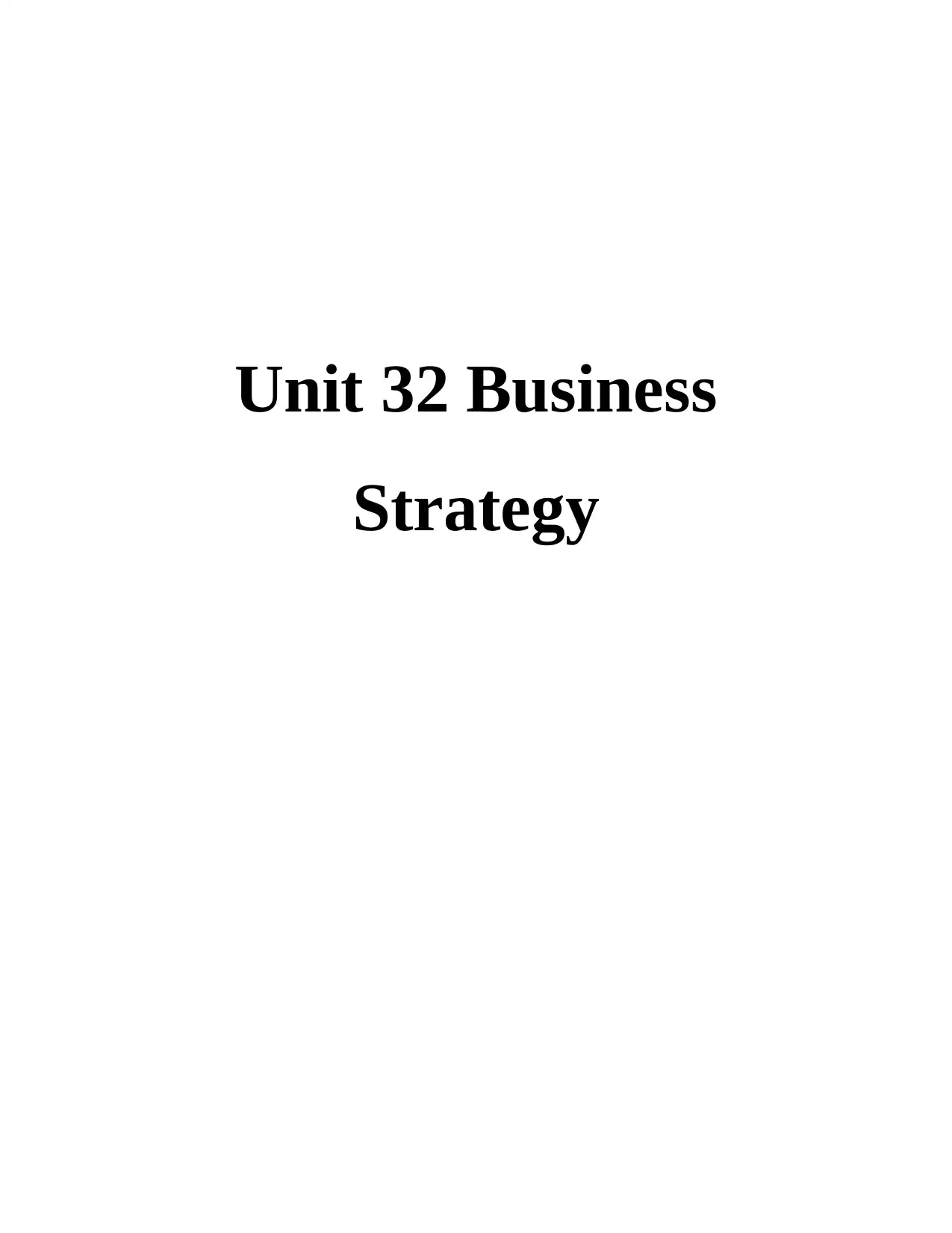
Unit 32 Business
Strategy
Strategy
Paraphrase This Document
Need a fresh take? Get an instant paraphrase of this document with our AI Paraphraser
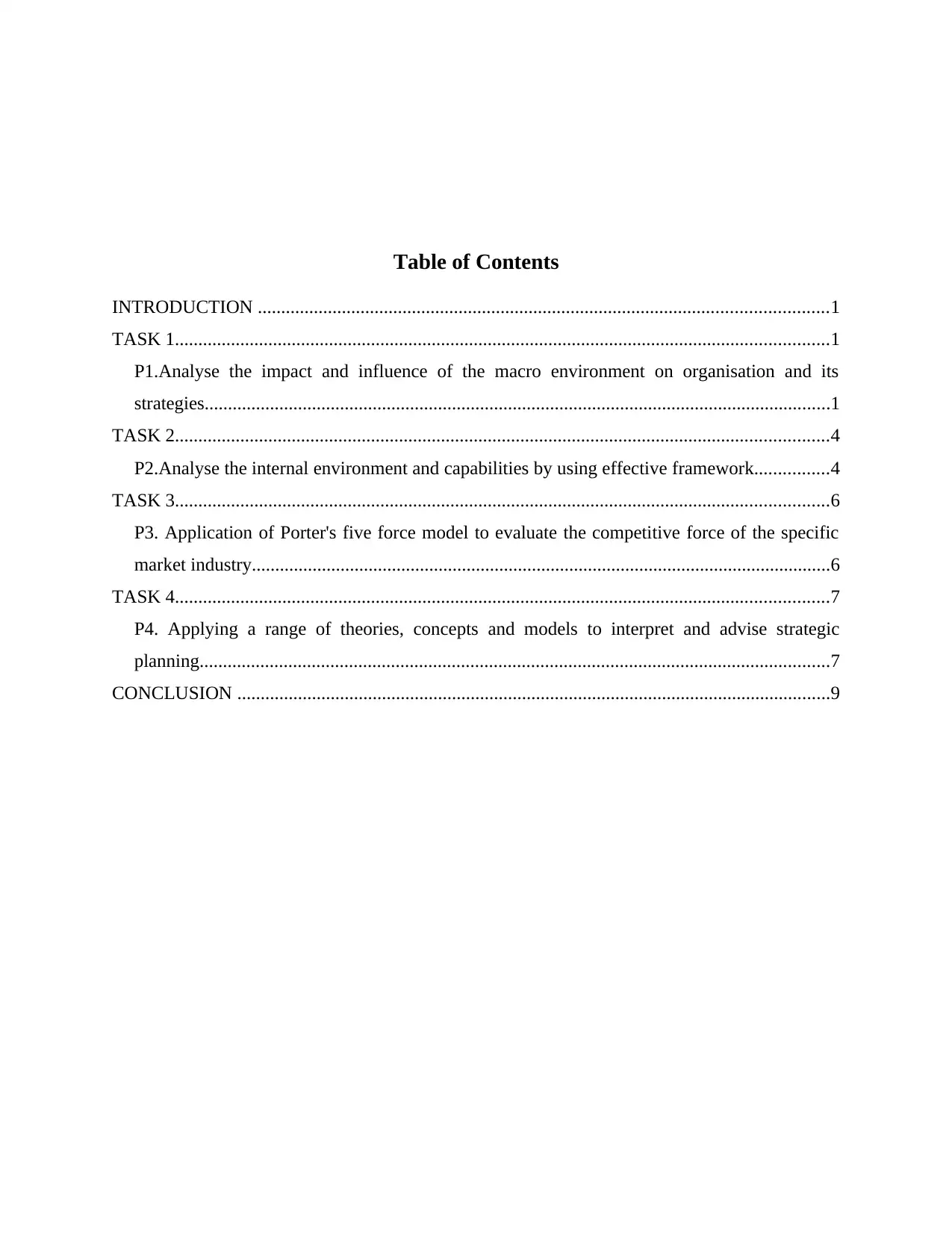
Table of Contents
INTRODUCTION ..........................................................................................................................1
TASK 1............................................................................................................................................1
P1.Analyse the impact and influence of the macro environment on organisation and its
strategies......................................................................................................................................1
TASK 2............................................................................................................................................4
P2.Analyse the internal environment and capabilities by using effective framework................4
TASK 3............................................................................................................................................6
P3. Application of Porter's five force model to evaluate the competitive force of the specific
market industry............................................................................................................................6
TASK 4............................................................................................................................................7
P4. Applying a range of theories, concepts and models to interpret and advise strategic
planning.......................................................................................................................................7
CONCLUSION ...............................................................................................................................9
INTRODUCTION ..........................................................................................................................1
TASK 1............................................................................................................................................1
P1.Analyse the impact and influence of the macro environment on organisation and its
strategies......................................................................................................................................1
TASK 2............................................................................................................................................4
P2.Analyse the internal environment and capabilities by using effective framework................4
TASK 3............................................................................................................................................6
P3. Application of Porter's five force model to evaluate the competitive force of the specific
market industry............................................................................................................................6
TASK 4............................................................................................................................................7
P4. Applying a range of theories, concepts and models to interpret and advise strategic
planning.......................................................................................................................................7
CONCLUSION ...............................................................................................................................9
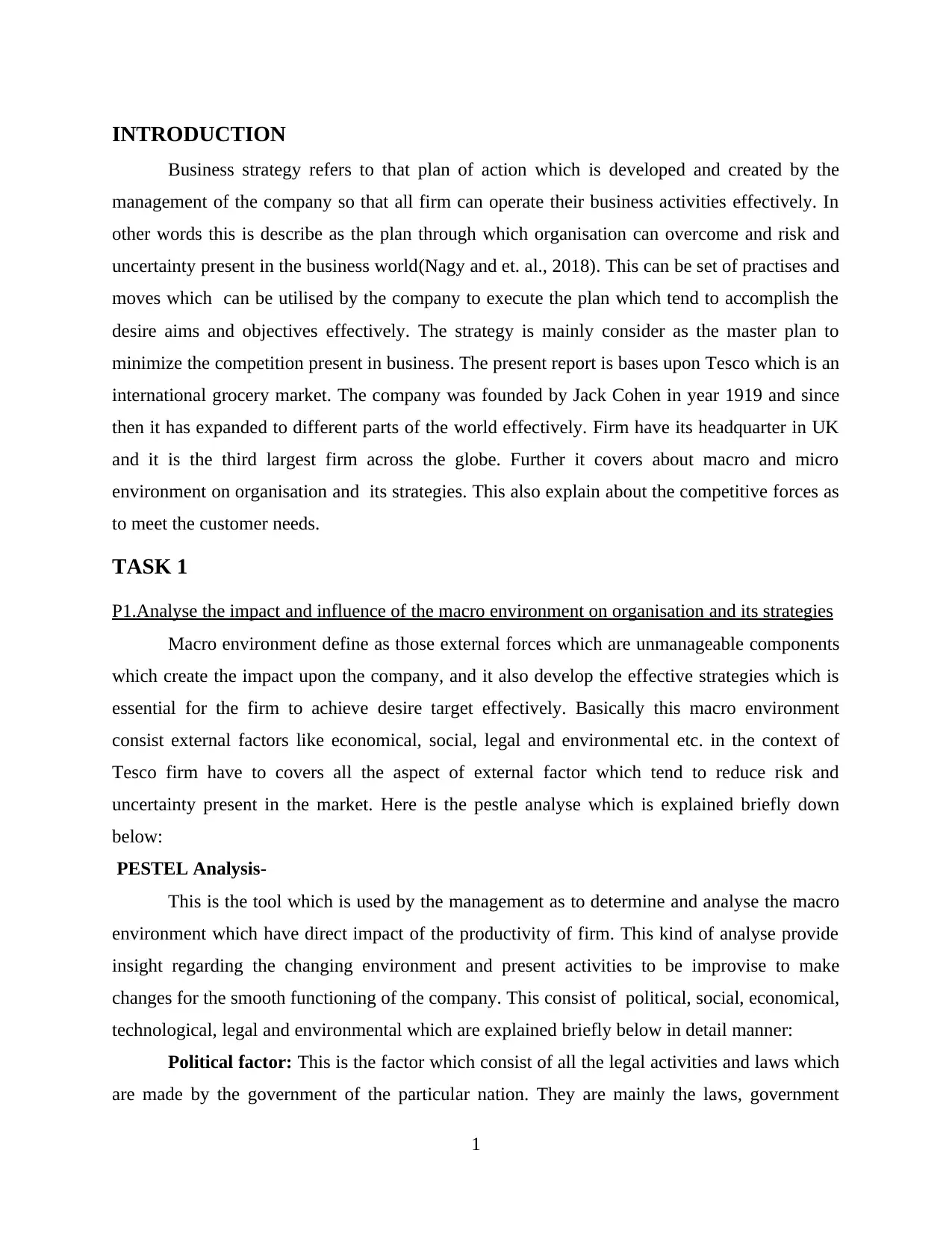
INTRODUCTION
Business strategy refers to that plan of action which is developed and created by the
management of the company so that all firm can operate their business activities effectively. In
other words this is describe as the plan through which organisation can overcome and risk and
uncertainty present in the business world(Nagy and et. al., 2018). This can be set of practises and
moves which can be utilised by the company to execute the plan which tend to accomplish the
desire aims and objectives effectively. The strategy is mainly consider as the master plan to
minimize the competition present in business. The present report is bases upon Tesco which is an
international grocery market. The company was founded by Jack Cohen in year 1919 and since
then it has expanded to different parts of the world effectively. Firm have its headquarter in UK
and it is the third largest firm across the globe. Further it covers about macro and micro
environment on organisation and its strategies. This also explain about the competitive forces as
to meet the customer needs.
TASK 1
P1.Analyse the impact and influence of the macro environment on organisation and its strategies
Macro environment define as those external forces which are unmanageable components
which create the impact upon the company, and it also develop the effective strategies which is
essential for the firm to achieve desire target effectively. Basically this macro environment
consist external factors like economical, social, legal and environmental etc. in the context of
Tesco firm have to covers all the aspect of external factor which tend to reduce risk and
uncertainty present in the market. Here is the pestle analyse which is explained briefly down
below:
PESTEL Analysis-
This is the tool which is used by the management as to determine and analyse the macro
environment which have direct impact of the productivity of firm. This kind of analyse provide
insight regarding the changing environment and present activities to be improvise to make
changes for the smooth functioning of the company. This consist of political, social, economical,
technological, legal and environmental which are explained briefly below in detail manner:
Political factor: This is the factor which consist of all the legal activities and laws which
are made by the government of the particular nation. They are mainly the laws, government
1
Business strategy refers to that plan of action which is developed and created by the
management of the company so that all firm can operate their business activities effectively. In
other words this is describe as the plan through which organisation can overcome and risk and
uncertainty present in the business world(Nagy and et. al., 2018). This can be set of practises and
moves which can be utilised by the company to execute the plan which tend to accomplish the
desire aims and objectives effectively. The strategy is mainly consider as the master plan to
minimize the competition present in business. The present report is bases upon Tesco which is an
international grocery market. The company was founded by Jack Cohen in year 1919 and since
then it has expanded to different parts of the world effectively. Firm have its headquarter in UK
and it is the third largest firm across the globe. Further it covers about macro and micro
environment on organisation and its strategies. This also explain about the competitive forces as
to meet the customer needs.
TASK 1
P1.Analyse the impact and influence of the macro environment on organisation and its strategies
Macro environment define as those external forces which are unmanageable components
which create the impact upon the company, and it also develop the effective strategies which is
essential for the firm to achieve desire target effectively. Basically this macro environment
consist external factors like economical, social, legal and environmental etc. in the context of
Tesco firm have to covers all the aspect of external factor which tend to reduce risk and
uncertainty present in the market. Here is the pestle analyse which is explained briefly down
below:
PESTEL Analysis-
This is the tool which is used by the management as to determine and analyse the macro
environment which have direct impact of the productivity of firm. This kind of analyse provide
insight regarding the changing environment and present activities to be improvise to make
changes for the smooth functioning of the company. This consist of political, social, economical,
technological, legal and environmental which are explained briefly below in detail manner:
Political factor: This is the factor which consist of all the legal activities and laws which
are made by the government of the particular nation. They are mainly the laws, government
1
⊘ This is a preview!⊘
Do you want full access?
Subscribe today to unlock all pages.

Trusted by 1+ million students worldwide
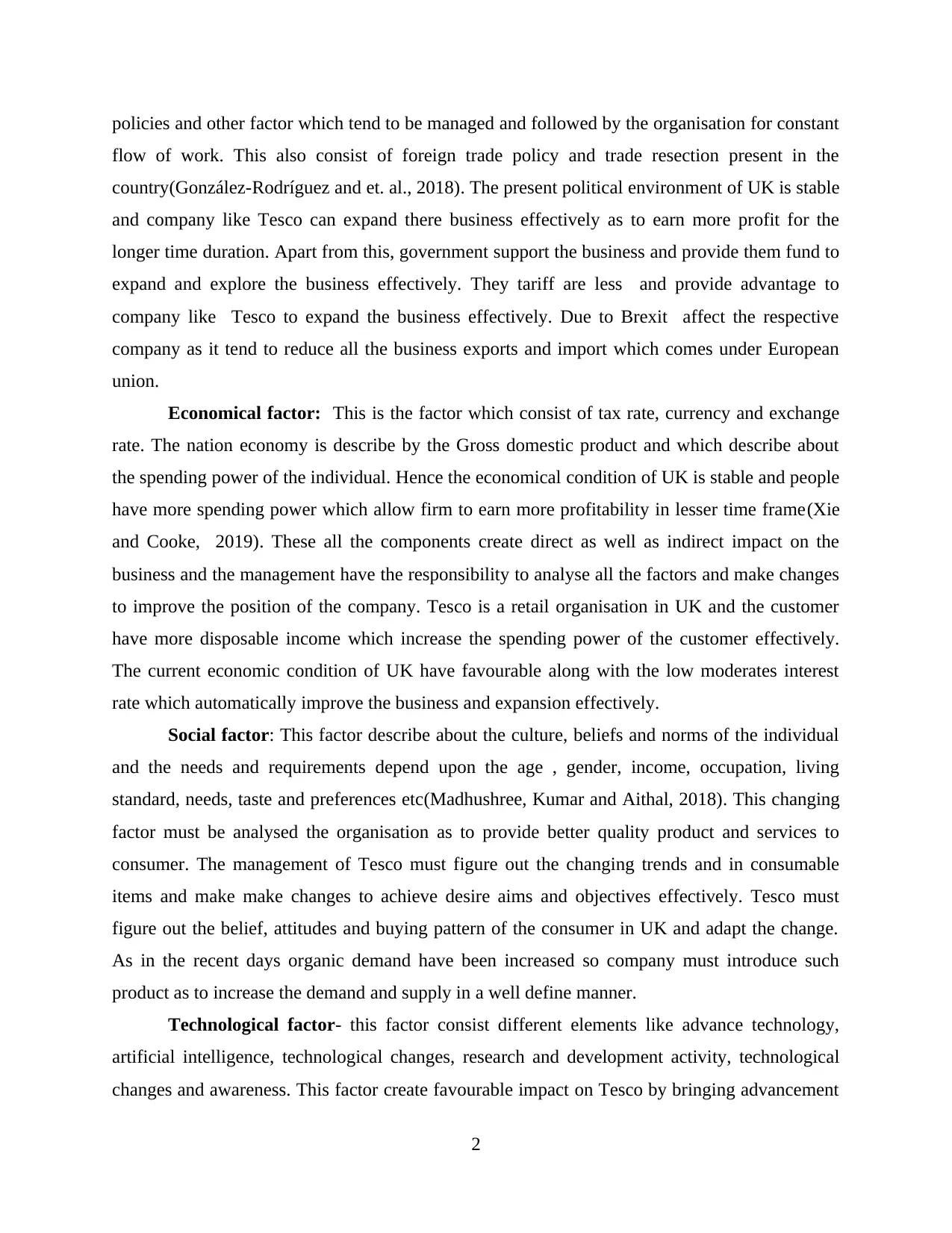
policies and other factor which tend to be managed and followed by the organisation for constant
flow of work. This also consist of foreign trade policy and trade resection present in the
country(González-Rodríguez and et. al., 2018). The present political environment of UK is stable
and company like Tesco can expand there business effectively as to earn more profit for the
longer time duration. Apart from this, government support the business and provide them fund to
expand and explore the business effectively. They tariff are less and provide advantage to
company like Tesco to expand the business effectively. Due to Brexit affect the respective
company as it tend to reduce all the business exports and import which comes under European
union.
Economical factor: This is the factor which consist of tax rate, currency and exchange
rate. The nation economy is describe by the Gross domestic product and which describe about
the spending power of the individual. Hence the economical condition of UK is stable and people
have more spending power which allow firm to earn more profitability in lesser time frame(Xie
and Cooke, 2019). These all the components create direct as well as indirect impact on the
business and the management have the responsibility to analyse all the factors and make changes
to improve the position of the company. Tesco is a retail organisation in UK and the customer
have more disposable income which increase the spending power of the customer effectively.
The current economic condition of UK have favourable along with the low moderates interest
rate which automatically improve the business and expansion effectively.
Social factor: This factor describe about the culture, beliefs and norms of the individual
and the needs and requirements depend upon the age , gender, income, occupation, living
standard, needs, taste and preferences etc(Madhushree, Kumar and Aithal, 2018). This changing
factor must be analysed the organisation as to provide better quality product and services to
consumer. The management of Tesco must figure out the changing trends and in consumable
items and make make changes to achieve desire aims and objectives effectively. Tesco must
figure out the belief, attitudes and buying pattern of the consumer in UK and adapt the change.
As in the recent days organic demand have been increased so company must introduce such
product as to increase the demand and supply in a well define manner.
Technological factor- this factor consist different elements like advance technology,
artificial intelligence, technological changes, research and development activity, technological
changes and awareness. This factor create favourable impact on Tesco by bringing advancement
2
flow of work. This also consist of foreign trade policy and trade resection present in the
country(González-Rodríguez and et. al., 2018). The present political environment of UK is stable
and company like Tesco can expand there business effectively as to earn more profit for the
longer time duration. Apart from this, government support the business and provide them fund to
expand and explore the business effectively. They tariff are less and provide advantage to
company like Tesco to expand the business effectively. Due to Brexit affect the respective
company as it tend to reduce all the business exports and import which comes under European
union.
Economical factor: This is the factor which consist of tax rate, currency and exchange
rate. The nation economy is describe by the Gross domestic product and which describe about
the spending power of the individual. Hence the economical condition of UK is stable and people
have more spending power which allow firm to earn more profitability in lesser time frame(Xie
and Cooke, 2019). These all the components create direct as well as indirect impact on the
business and the management have the responsibility to analyse all the factors and make changes
to improve the position of the company. Tesco is a retail organisation in UK and the customer
have more disposable income which increase the spending power of the customer effectively.
The current economic condition of UK have favourable along with the low moderates interest
rate which automatically improve the business and expansion effectively.
Social factor: This factor describe about the culture, beliefs and norms of the individual
and the needs and requirements depend upon the age , gender, income, occupation, living
standard, needs, taste and preferences etc(Madhushree, Kumar and Aithal, 2018). This changing
factor must be analysed the organisation as to provide better quality product and services to
consumer. The management of Tesco must figure out the changing trends and in consumable
items and make make changes to achieve desire aims and objectives effectively. Tesco must
figure out the belief, attitudes and buying pattern of the consumer in UK and adapt the change.
As in the recent days organic demand have been increased so company must introduce such
product as to increase the demand and supply in a well define manner.
Technological factor- this factor consist different elements like advance technology,
artificial intelligence, technological changes, research and development activity, technological
changes and awareness. This factor create favourable impact on Tesco by bringing advancement
2
Paraphrase This Document
Need a fresh take? Get an instant paraphrase of this document with our AI Paraphraser
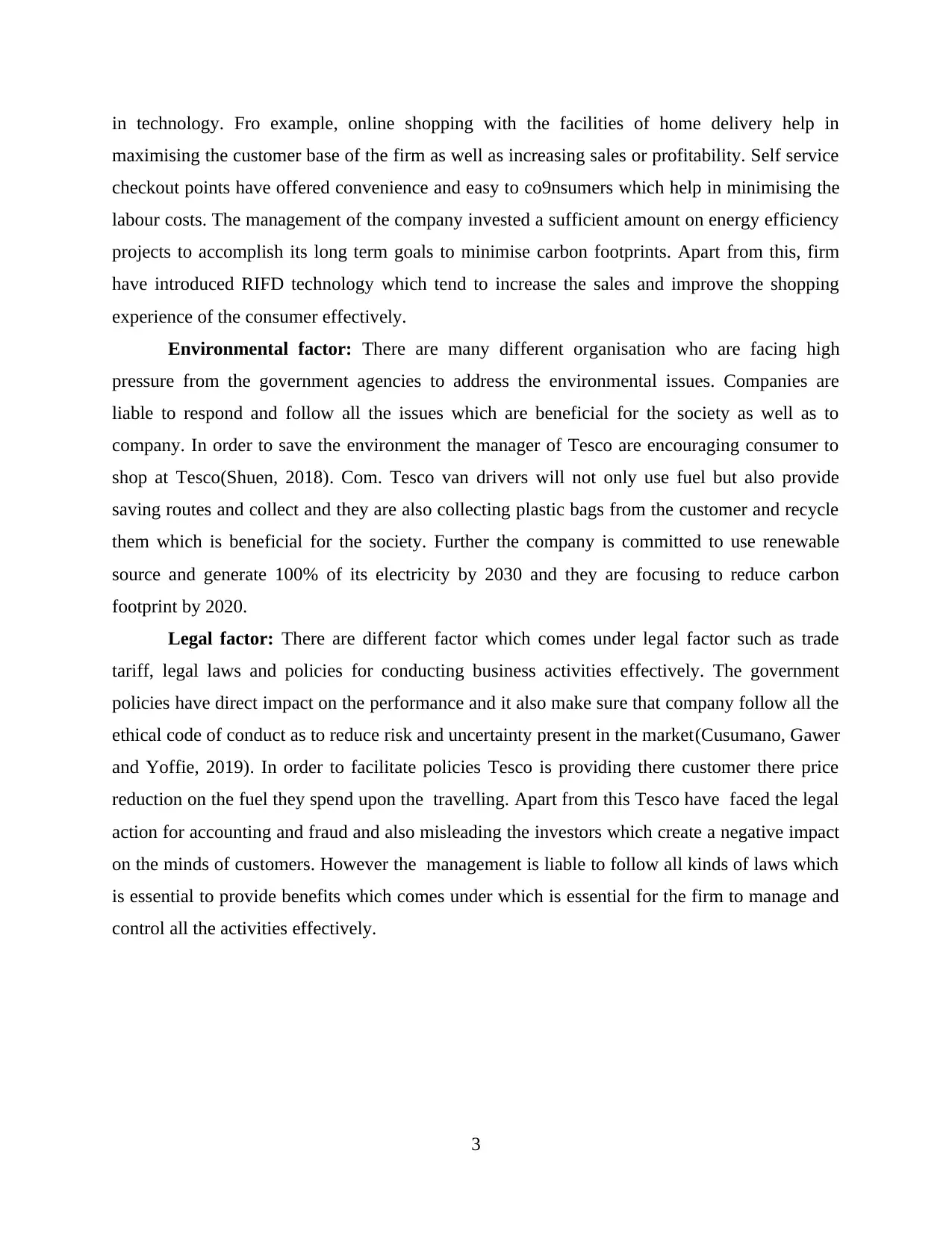
in technology. Fro example, online shopping with the facilities of home delivery help in
maximising the customer base of the firm as well as increasing sales or profitability. Self service
checkout points have offered convenience and easy to co9nsumers which help in minimising the
labour costs. The management of the company invested a sufficient amount on energy efficiency
projects to accomplish its long term goals to minimise carbon footprints. Apart from this, firm
have introduced RIFD technology which tend to increase the sales and improve the shopping
experience of the consumer effectively.
Environmental factor: There are many different organisation who are facing high
pressure from the government agencies to address the environmental issues. Companies are
liable to respond and follow all the issues which are beneficial for the society as well as to
company. In order to save the environment the manager of Tesco are encouraging consumer to
shop at Tesco(Shuen, 2018). Com. Tesco van drivers will not only use fuel but also provide
saving routes and collect and they are also collecting plastic bags from the customer and recycle
them which is beneficial for the society. Further the company is committed to use renewable
source and generate 100% of its electricity by 2030 and they are focusing to reduce carbon
footprint by 2020.
Legal factor: There are different factor which comes under legal factor such as trade
tariff, legal laws and policies for conducting business activities effectively. The government
policies have direct impact on the performance and it also make sure that company follow all the
ethical code of conduct as to reduce risk and uncertainty present in the market(Cusumano, Gawer
and Yoffie, 2019). In order to facilitate policies Tesco is providing there customer there price
reduction on the fuel they spend upon the travelling. Apart from this Tesco have faced the legal
action for accounting and fraud and also misleading the investors which create a negative impact
on the minds of customers. However the management is liable to follow all kinds of laws which
is essential to provide benefits which comes under which is essential for the firm to manage and
control all the activities effectively.
3
maximising the customer base of the firm as well as increasing sales or profitability. Self service
checkout points have offered convenience and easy to co9nsumers which help in minimising the
labour costs. The management of the company invested a sufficient amount on energy efficiency
projects to accomplish its long term goals to minimise carbon footprints. Apart from this, firm
have introduced RIFD technology which tend to increase the sales and improve the shopping
experience of the consumer effectively.
Environmental factor: There are many different organisation who are facing high
pressure from the government agencies to address the environmental issues. Companies are
liable to respond and follow all the issues which are beneficial for the society as well as to
company. In order to save the environment the manager of Tesco are encouraging consumer to
shop at Tesco(Shuen, 2018). Com. Tesco van drivers will not only use fuel but also provide
saving routes and collect and they are also collecting plastic bags from the customer and recycle
them which is beneficial for the society. Further the company is committed to use renewable
source and generate 100% of its electricity by 2030 and they are focusing to reduce carbon
footprint by 2020.
Legal factor: There are different factor which comes under legal factor such as trade
tariff, legal laws and policies for conducting business activities effectively. The government
policies have direct impact on the performance and it also make sure that company follow all the
ethical code of conduct as to reduce risk and uncertainty present in the market(Cusumano, Gawer
and Yoffie, 2019). In order to facilitate policies Tesco is providing there customer there price
reduction on the fuel they spend upon the travelling. Apart from this Tesco have faced the legal
action for accounting and fraud and also misleading the investors which create a negative impact
on the minds of customers. However the management is liable to follow all kinds of laws which
is essential to provide benefits which comes under which is essential for the firm to manage and
control all the activities effectively.
3
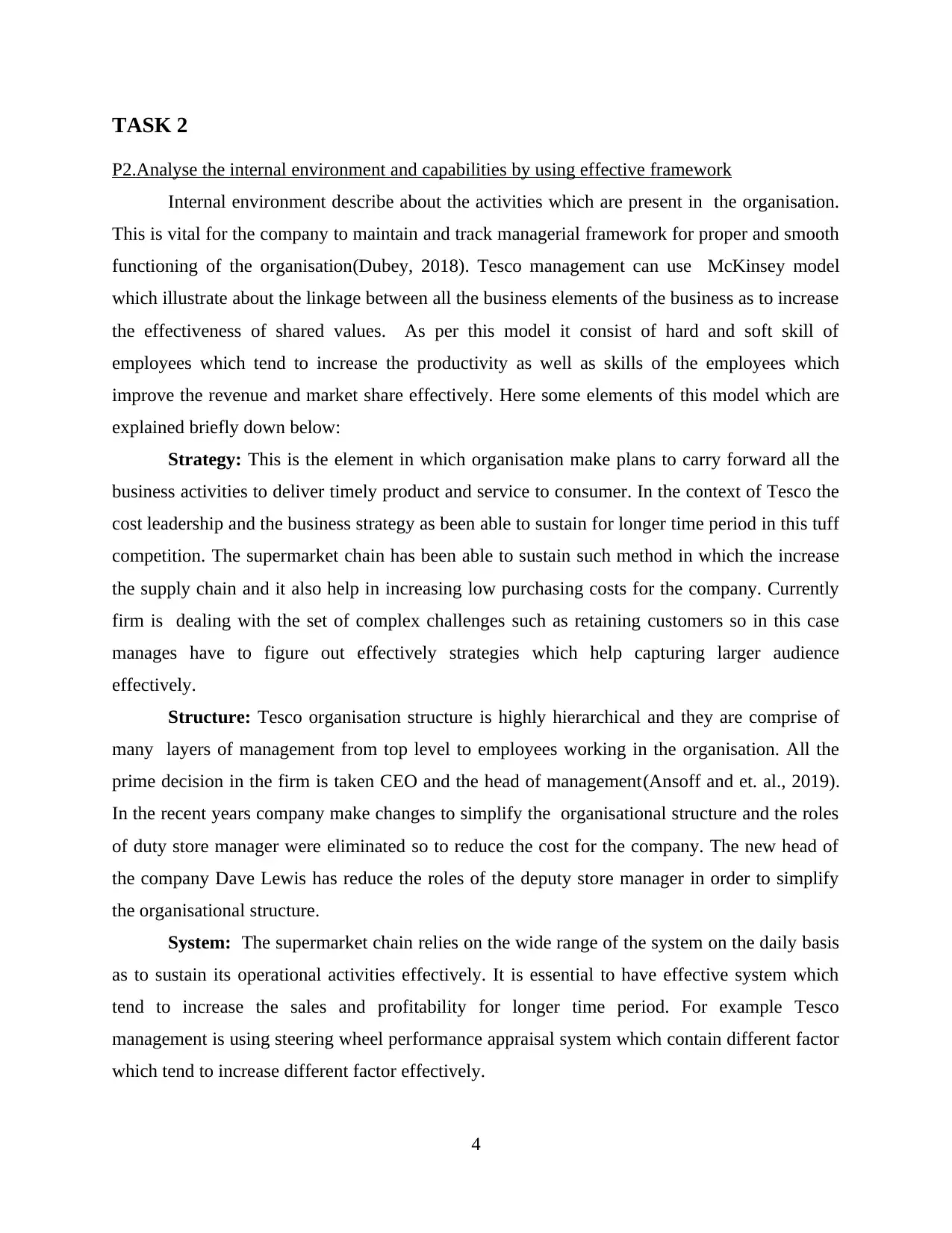
TASK 2
P2.Analyse the internal environment and capabilities by using effective framework
Internal environment describe about the activities which are present in the organisation.
This is vital for the company to maintain and track managerial framework for proper and smooth
functioning of the organisation(Dubey, 2018). Tesco management can use McKinsey model
which illustrate about the linkage between all the business elements of the business as to increase
the effectiveness of shared values. As per this model it consist of hard and soft skill of
employees which tend to increase the productivity as well as skills of the employees which
improve the revenue and market share effectively. Here some elements of this model which are
explained briefly down below:
Strategy: This is the element in which organisation make plans to carry forward all the
business activities to deliver timely product and service to consumer. In the context of Tesco the
cost leadership and the business strategy as been able to sustain for longer time period in this tuff
competition. The supermarket chain has been able to sustain such method in which the increase
the supply chain and it also help in increasing low purchasing costs for the company. Currently
firm is dealing with the set of complex challenges such as retaining customers so in this case
manages have to figure out effectively strategies which help capturing larger audience
effectively.
Structure: Tesco organisation structure is highly hierarchical and they are comprise of
many layers of management from top level to employees working in the organisation. All the
prime decision in the firm is taken CEO and the head of management(Ansoff and et. al., 2019).
In the recent years company make changes to simplify the organisational structure and the roles
of duty store manager were eliminated so to reduce the cost for the company. The new head of
the company Dave Lewis has reduce the roles of the deputy store manager in order to simplify
the organisational structure.
System: The supermarket chain relies on the wide range of the system on the daily basis
as to sustain its operational activities effectively. It is essential to have effective system which
tend to increase the sales and profitability for longer time period. For example Tesco
management is using steering wheel performance appraisal system which contain different factor
which tend to increase different factor effectively.
4
P2.Analyse the internal environment and capabilities by using effective framework
Internal environment describe about the activities which are present in the organisation.
This is vital for the company to maintain and track managerial framework for proper and smooth
functioning of the organisation(Dubey, 2018). Tesco management can use McKinsey model
which illustrate about the linkage between all the business elements of the business as to increase
the effectiveness of shared values. As per this model it consist of hard and soft skill of
employees which tend to increase the productivity as well as skills of the employees which
improve the revenue and market share effectively. Here some elements of this model which are
explained briefly down below:
Strategy: This is the element in which organisation make plans to carry forward all the
business activities to deliver timely product and service to consumer. In the context of Tesco the
cost leadership and the business strategy as been able to sustain for longer time period in this tuff
competition. The supermarket chain has been able to sustain such method in which the increase
the supply chain and it also help in increasing low purchasing costs for the company. Currently
firm is dealing with the set of complex challenges such as retaining customers so in this case
manages have to figure out effectively strategies which help capturing larger audience
effectively.
Structure: Tesco organisation structure is highly hierarchical and they are comprise of
many layers of management from top level to employees working in the organisation. All the
prime decision in the firm is taken CEO and the head of management(Ansoff and et. al., 2019).
In the recent years company make changes to simplify the organisational structure and the roles
of duty store manager were eliminated so to reduce the cost for the company. The new head of
the company Dave Lewis has reduce the roles of the deputy store manager in order to simplify
the organisational structure.
System: The supermarket chain relies on the wide range of the system on the daily basis
as to sustain its operational activities effectively. It is essential to have effective system which
tend to increase the sales and profitability for longer time period. For example Tesco
management is using steering wheel performance appraisal system which contain different factor
which tend to increase different factor effectively.
4
⊘ This is a preview!⊘
Do you want full access?
Subscribe today to unlock all pages.

Trusted by 1+ million students worldwide
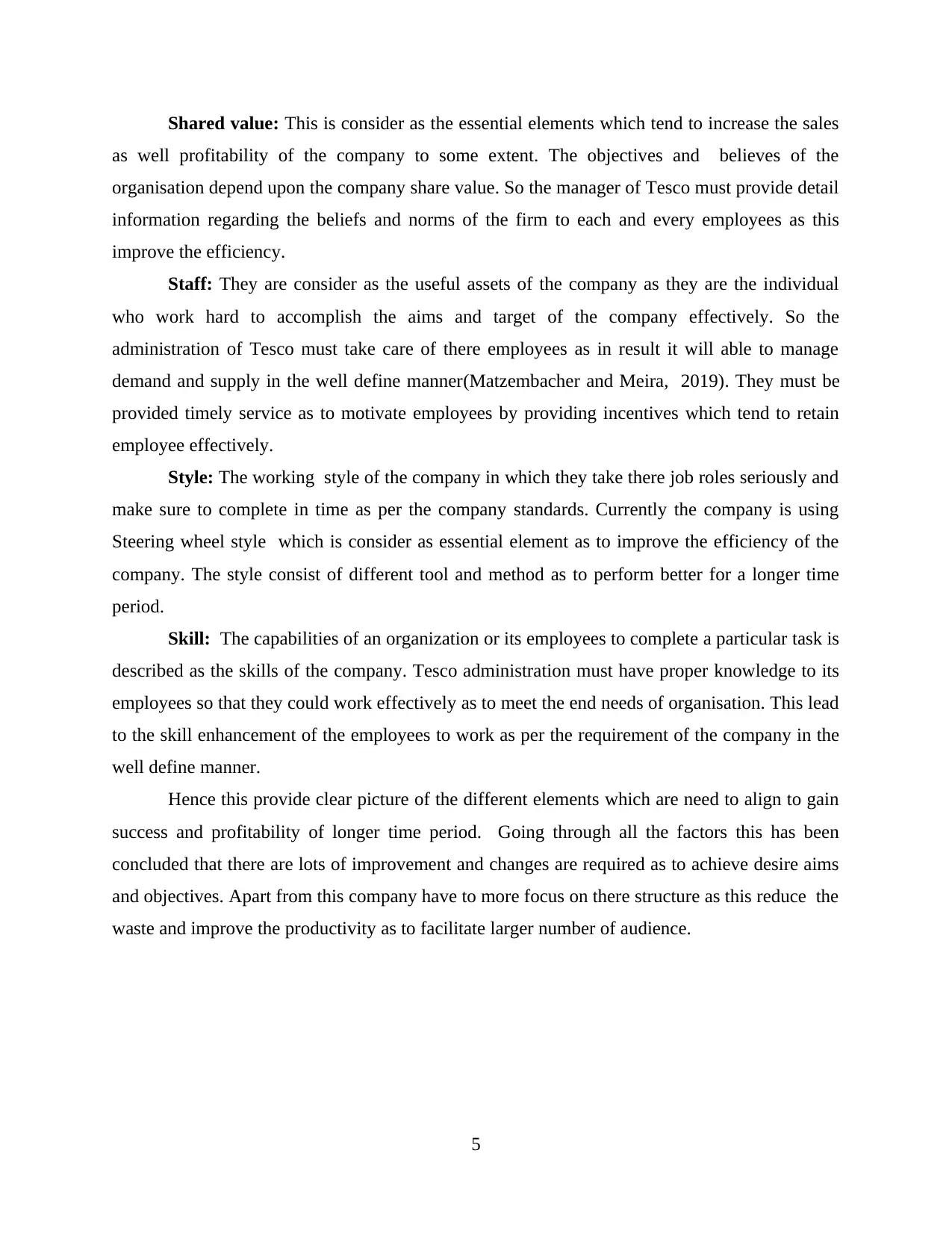
Shared value: This is consider as the essential elements which tend to increase the sales
as well profitability of the company to some extent. The objectives and believes of the
organisation depend upon the company share value. So the manager of Tesco must provide detail
information regarding the beliefs and norms of the firm to each and every employees as this
improve the efficiency.
Staff: They are consider as the useful assets of the company as they are the individual
who work hard to accomplish the aims and target of the company effectively. So the
administration of Tesco must take care of there employees as in result it will able to manage
demand and supply in the well define manner(Matzembacher and Meira, 2019). They must be
provided timely service as to motivate employees by providing incentives which tend to retain
employee effectively.
Style: The working style of the company in which they take there job roles seriously and
make sure to complete in time as per the company standards. Currently the company is using
Steering wheel style which is consider as essential element as to improve the efficiency of the
company. The style consist of different tool and method as to perform better for a longer time
period.
Skill: The capabilities of an organization or its employees to complete a particular task is
described as the skills of the company. Tesco administration must have proper knowledge to its
employees so that they could work effectively as to meet the end needs of organisation. This lead
to the skill enhancement of the employees to work as per the requirement of the company in the
well define manner.
Hence this provide clear picture of the different elements which are need to align to gain
success and profitability of longer time period. Going through all the factors this has been
concluded that there are lots of improvement and changes are required as to achieve desire aims
and objectives. Apart from this company have to more focus on there structure as this reduce the
waste and improve the productivity as to facilitate larger number of audience.
5
as well profitability of the company to some extent. The objectives and believes of the
organisation depend upon the company share value. So the manager of Tesco must provide detail
information regarding the beliefs and norms of the firm to each and every employees as this
improve the efficiency.
Staff: They are consider as the useful assets of the company as they are the individual
who work hard to accomplish the aims and target of the company effectively. So the
administration of Tesco must take care of there employees as in result it will able to manage
demand and supply in the well define manner(Matzembacher and Meira, 2019). They must be
provided timely service as to motivate employees by providing incentives which tend to retain
employee effectively.
Style: The working style of the company in which they take there job roles seriously and
make sure to complete in time as per the company standards. Currently the company is using
Steering wheel style which is consider as essential element as to improve the efficiency of the
company. The style consist of different tool and method as to perform better for a longer time
period.
Skill: The capabilities of an organization or its employees to complete a particular task is
described as the skills of the company. Tesco administration must have proper knowledge to its
employees so that they could work effectively as to meet the end needs of organisation. This lead
to the skill enhancement of the employees to work as per the requirement of the company in the
well define manner.
Hence this provide clear picture of the different elements which are need to align to gain
success and profitability of longer time period. Going through all the factors this has been
concluded that there are lots of improvement and changes are required as to achieve desire aims
and objectives. Apart from this company have to more focus on there structure as this reduce the
waste and improve the productivity as to facilitate larger number of audience.
5
Paraphrase This Document
Need a fresh take? Get an instant paraphrase of this document with our AI Paraphraser
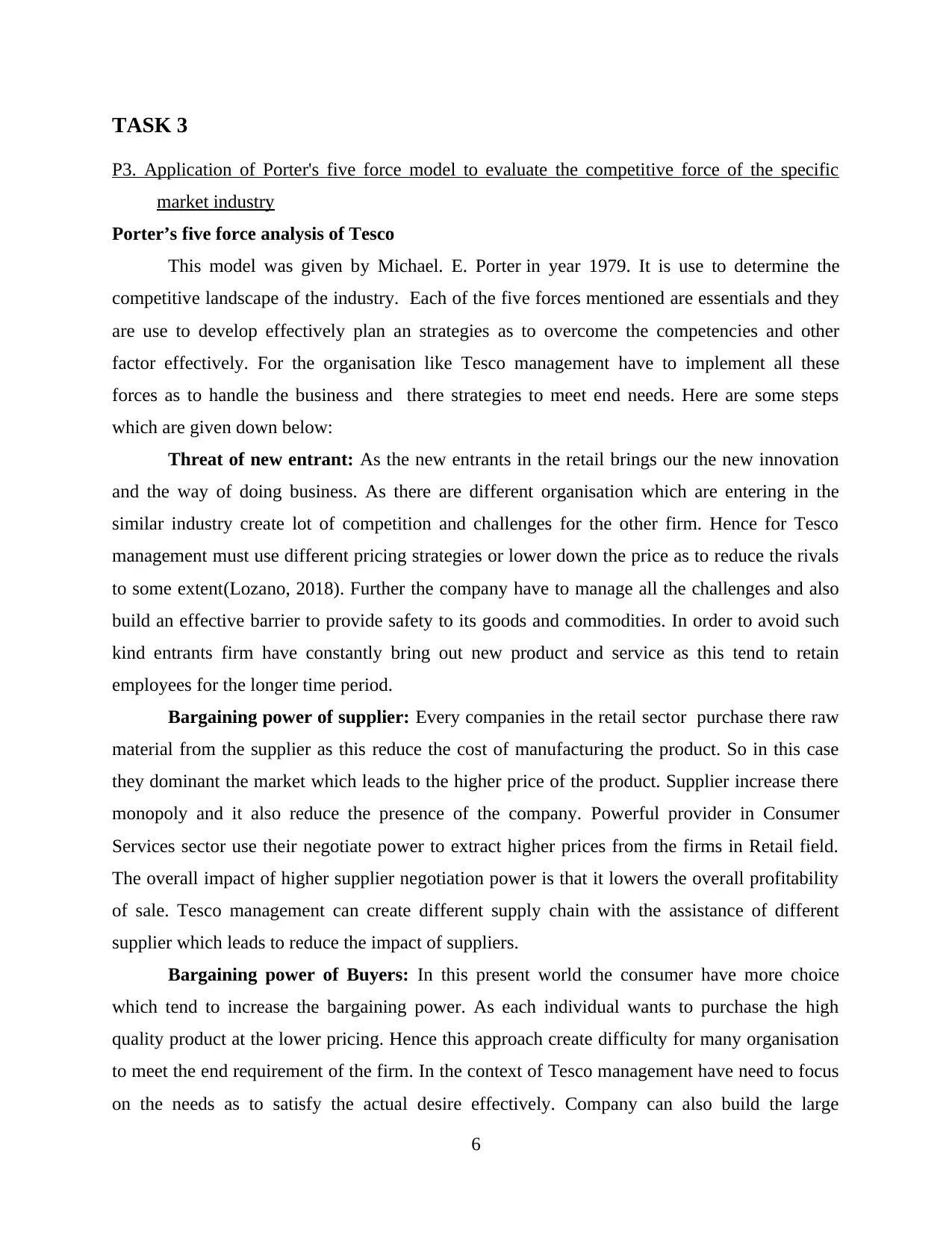
TASK 3
P3. Application of Porter's five force model to evaluate the competitive force of the specific
market industry
Porter’s five force analysis of Tesco
This model was given by Michael. E. Porter in year 1979. It is use to determine the
competitive landscape of the industry. Each of the five forces mentioned are essentials and they
are use to develop effectively plan an strategies as to overcome the competencies and other
factor effectively. For the organisation like Tesco management have to implement all these
forces as to handle the business and there strategies to meet end needs. Here are some steps
which are given down below:
Threat of new entrant: As the new entrants in the retail brings our the new innovation
and the way of doing business. As there are different organisation which are entering in the
similar industry create lot of competition and challenges for the other firm. Hence for Tesco
management must use different pricing strategies or lower down the price as to reduce the rivals
to some extent(Lozano, 2018). Further the company have to manage all the challenges and also
build an effective barrier to provide safety to its goods and commodities. In order to avoid such
kind entrants firm have constantly bring out new product and service as this tend to retain
employees for the longer time period.
Bargaining power of supplier: Every companies in the retail sector purchase there raw
material from the supplier as this reduce the cost of manufacturing the product. So in this case
they dominant the market which leads to the higher price of the product. Supplier increase there
monopoly and it also reduce the presence of the company. Powerful provider in Consumer
Services sector use their negotiate power to extract higher prices from the firms in Retail field.
The overall impact of higher supplier negotiation power is that it lowers the overall profitability
of sale. Tesco management can create different supply chain with the assistance of different
supplier which leads to reduce the impact of suppliers.
Bargaining power of Buyers: In this present world the consumer have more choice
which tend to increase the bargaining power. As each individual wants to purchase the high
quality product at the lower pricing. Hence this approach create difficulty for many organisation
to meet the end requirement of the firm. In the context of Tesco management have need to focus
on the needs as to satisfy the actual desire effectively. Company can also build the large
6
P3. Application of Porter's five force model to evaluate the competitive force of the specific
market industry
Porter’s five force analysis of Tesco
This model was given by Michael. E. Porter in year 1979. It is use to determine the
competitive landscape of the industry. Each of the five forces mentioned are essentials and they
are use to develop effectively plan an strategies as to overcome the competencies and other
factor effectively. For the organisation like Tesco management have to implement all these
forces as to handle the business and there strategies to meet end needs. Here are some steps
which are given down below:
Threat of new entrant: As the new entrants in the retail brings our the new innovation
and the way of doing business. As there are different organisation which are entering in the
similar industry create lot of competition and challenges for the other firm. Hence for Tesco
management must use different pricing strategies or lower down the price as to reduce the rivals
to some extent(Lozano, 2018). Further the company have to manage all the challenges and also
build an effective barrier to provide safety to its goods and commodities. In order to avoid such
kind entrants firm have constantly bring out new product and service as this tend to retain
employees for the longer time period.
Bargaining power of supplier: Every companies in the retail sector purchase there raw
material from the supplier as this reduce the cost of manufacturing the product. So in this case
they dominant the market which leads to the higher price of the product. Supplier increase there
monopoly and it also reduce the presence of the company. Powerful provider in Consumer
Services sector use their negotiate power to extract higher prices from the firms in Retail field.
The overall impact of higher supplier negotiation power is that it lowers the overall profitability
of sale. Tesco management can create different supply chain with the assistance of different
supplier which leads to reduce the impact of suppliers.
Bargaining power of Buyers: In this present world the consumer have more choice
which tend to increase the bargaining power. As each individual wants to purchase the high
quality product at the lower pricing. Hence this approach create difficulty for many organisation
to meet the end requirement of the firm. In the context of Tesco management have need to focus
on the needs as to satisfy the actual desire effectively. Company can also build the large
6
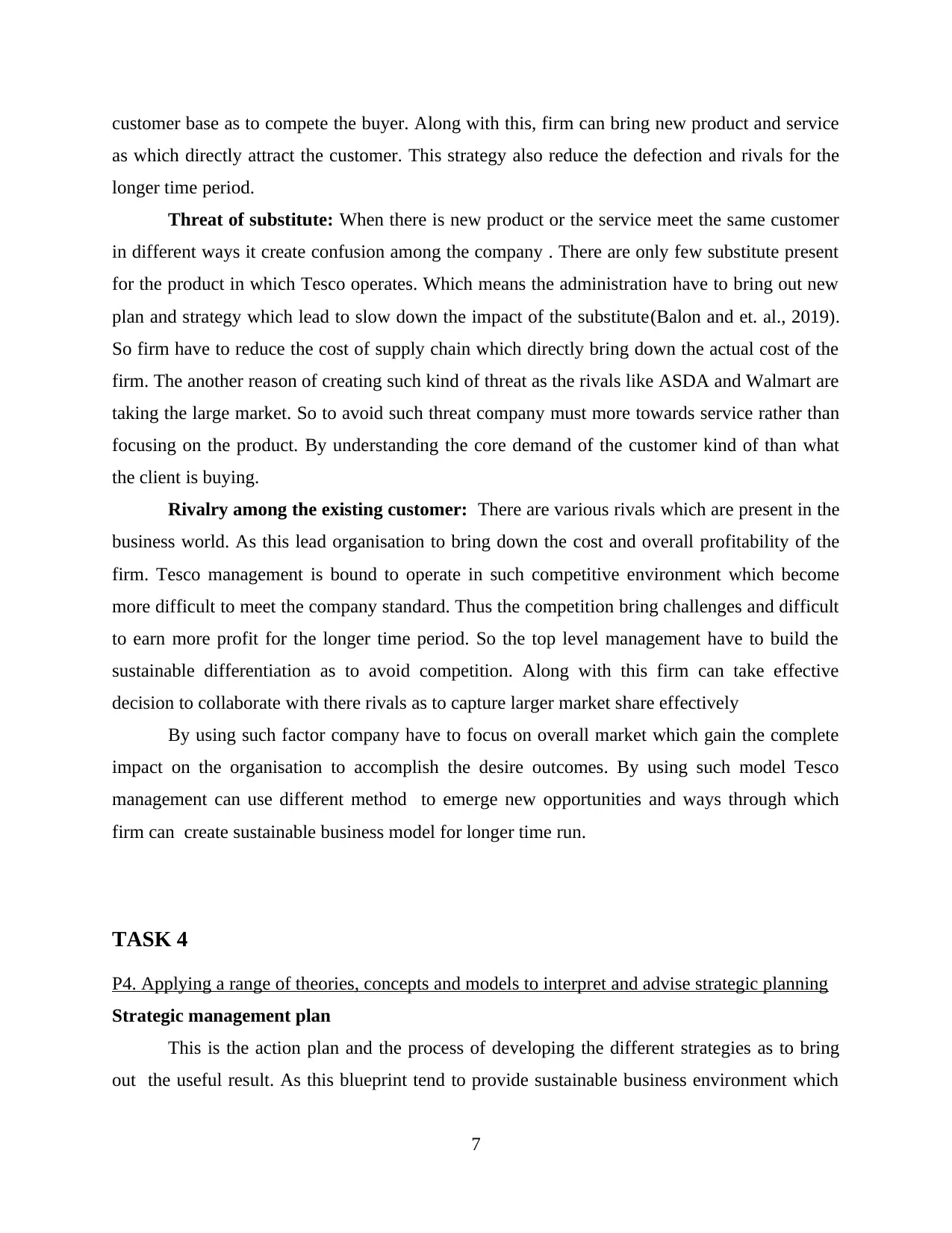
customer base as to compete the buyer. Along with this, firm can bring new product and service
as which directly attract the customer. This strategy also reduce the defection and rivals for the
longer time period.
Threat of substitute: When there is new product or the service meet the same customer
in different ways it create confusion among the company . There are only few substitute present
for the product in which Tesco operates. Which means the administration have to bring out new
plan and strategy which lead to slow down the impact of the substitute(Balon and et. al., 2019).
So firm have to reduce the cost of supply chain which directly bring down the actual cost of the
firm. The another reason of creating such kind of threat as the rivals like ASDA and Walmart are
taking the large market. So to avoid such threat company must more towards service rather than
focusing on the product. By understanding the core demand of the customer kind of than what
the client is buying.
Rivalry among the existing customer: There are various rivals which are present in the
business world. As this lead organisation to bring down the cost and overall profitability of the
firm. Tesco management is bound to operate in such competitive environment which become
more difficult to meet the company standard. Thus the competition bring challenges and difficult
to earn more profit for the longer time period. So the top level management have to build the
sustainable differentiation as to avoid competition. Along with this firm can take effective
decision to collaborate with there rivals as to capture larger market share effectively
By using such factor company have to focus on overall market which gain the complete
impact on the organisation to accomplish the desire outcomes. By using such model Tesco
management can use different method to emerge new opportunities and ways through which
firm can create sustainable business model for longer time run.
TASK 4
P4. Applying a range of theories, concepts and models to interpret and advise strategic planning
Strategic management plan
This is the action plan and the process of developing the different strategies as to bring
out the useful result. As this blueprint tend to provide sustainable business environment which
7
as which directly attract the customer. This strategy also reduce the defection and rivals for the
longer time period.
Threat of substitute: When there is new product or the service meet the same customer
in different ways it create confusion among the company . There are only few substitute present
for the product in which Tesco operates. Which means the administration have to bring out new
plan and strategy which lead to slow down the impact of the substitute(Balon and et. al., 2019).
So firm have to reduce the cost of supply chain which directly bring down the actual cost of the
firm. The another reason of creating such kind of threat as the rivals like ASDA and Walmart are
taking the large market. So to avoid such threat company must more towards service rather than
focusing on the product. By understanding the core demand of the customer kind of than what
the client is buying.
Rivalry among the existing customer: There are various rivals which are present in the
business world. As this lead organisation to bring down the cost and overall profitability of the
firm. Tesco management is bound to operate in such competitive environment which become
more difficult to meet the company standard. Thus the competition bring challenges and difficult
to earn more profit for the longer time period. So the top level management have to build the
sustainable differentiation as to avoid competition. Along with this firm can take effective
decision to collaborate with there rivals as to capture larger market share effectively
By using such factor company have to focus on overall market which gain the complete
impact on the organisation to accomplish the desire outcomes. By using such model Tesco
management can use different method to emerge new opportunities and ways through which
firm can create sustainable business model for longer time run.
TASK 4
P4. Applying a range of theories, concepts and models to interpret and advise strategic planning
Strategic management plan
This is the action plan and the process of developing the different strategies as to bring
out the useful result. As this blueprint tend to provide sustainable business environment which
7
⊘ This is a preview!⊘
Do you want full access?
Subscribe today to unlock all pages.

Trusted by 1+ million students worldwide
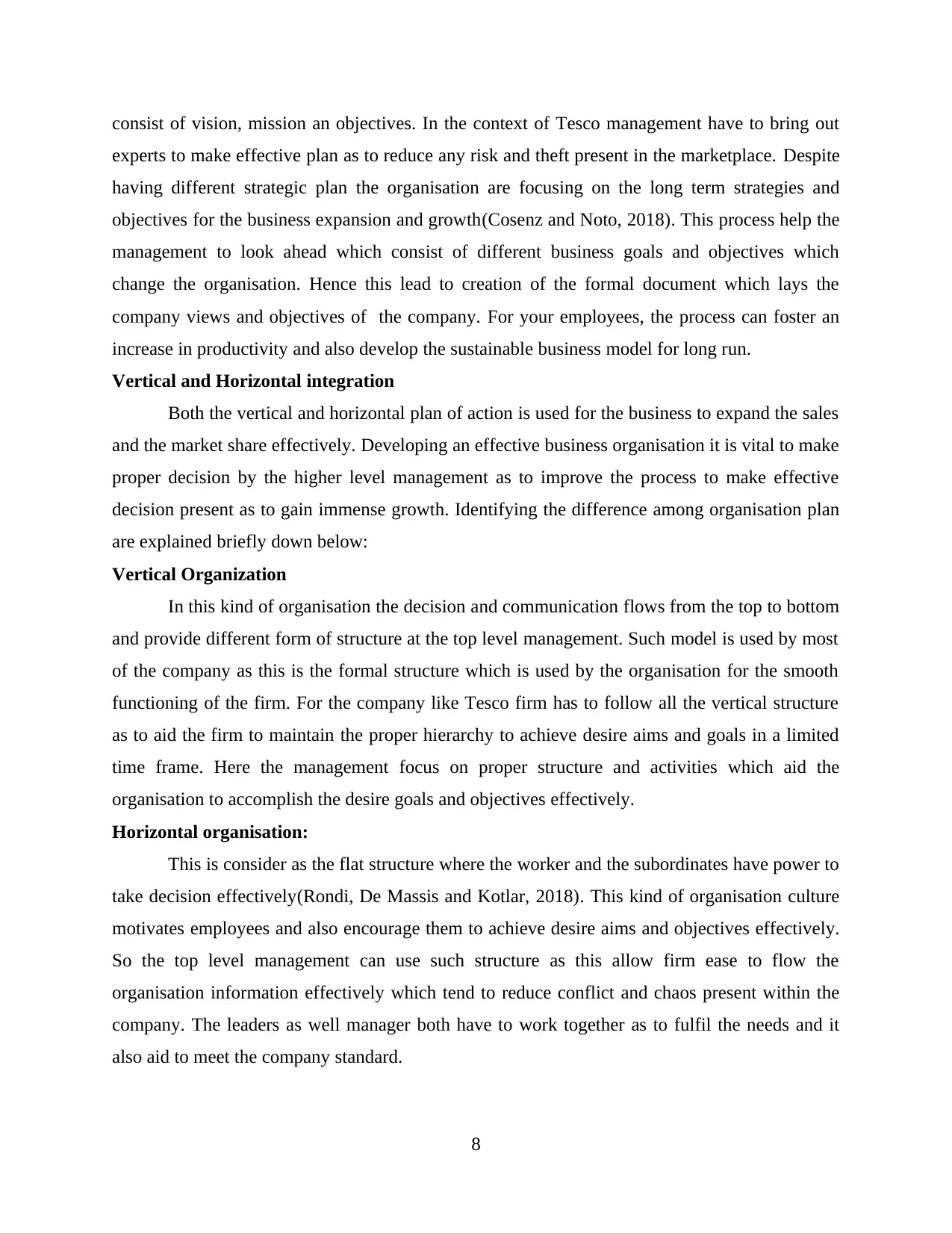
consist of vision, mission an objectives. In the context of Tesco management have to bring out
experts to make effective plan as to reduce any risk and theft present in the marketplace. Despite
having different strategic plan the organisation are focusing on the long term strategies and
objectives for the business expansion and growth(Cosenz and Noto, 2018). This process help the
management to look ahead which consist of different business goals and objectives which
change the organisation. Hence this lead to creation of the formal document which lays the
company views and objectives of the company. For your employees, the process can foster an
increase in productivity and also develop the sustainable business model for long run.
Vertical and Horizontal integration
Both the vertical and horizontal plan of action is used for the business to expand the sales
and the market share effectively. Developing an effective business organisation it is vital to make
proper decision by the higher level management as to improve the process to make effective
decision present as to gain immense growth. Identifying the difference among organisation plan
are explained briefly down below:
Vertical Organization
In this kind of organisation the decision and communication flows from the top to bottom
and provide different form of structure at the top level management. Such model is used by most
of the company as this is the formal structure which is used by the organisation for the smooth
functioning of the firm. For the company like Tesco firm has to follow all the vertical structure
as to aid the firm to maintain the proper hierarchy to achieve desire aims and goals in a limited
time frame. Here the management focus on proper structure and activities which aid the
organisation to accomplish the desire goals and objectives effectively.
Horizontal organisation:
This is consider as the flat structure where the worker and the subordinates have power to
take decision effectively(Rondi, De Massis and Kotlar, 2018). This kind of organisation culture
motivates employees and also encourage them to achieve desire aims and objectives effectively.
So the top level management can use such structure as this allow firm ease to flow the
organisation information effectively which tend to reduce conflict and chaos present within the
company. The leaders as well manager both have to work together as to fulfil the needs and it
also aid to meet the company standard.
8
experts to make effective plan as to reduce any risk and theft present in the marketplace. Despite
having different strategic plan the organisation are focusing on the long term strategies and
objectives for the business expansion and growth(Cosenz and Noto, 2018). This process help the
management to look ahead which consist of different business goals and objectives which
change the organisation. Hence this lead to creation of the formal document which lays the
company views and objectives of the company. For your employees, the process can foster an
increase in productivity and also develop the sustainable business model for long run.
Vertical and Horizontal integration
Both the vertical and horizontal plan of action is used for the business to expand the sales
and the market share effectively. Developing an effective business organisation it is vital to make
proper decision by the higher level management as to improve the process to make effective
decision present as to gain immense growth. Identifying the difference among organisation plan
are explained briefly down below:
Vertical Organization
In this kind of organisation the decision and communication flows from the top to bottom
and provide different form of structure at the top level management. Such model is used by most
of the company as this is the formal structure which is used by the organisation for the smooth
functioning of the firm. For the company like Tesco firm has to follow all the vertical structure
as to aid the firm to maintain the proper hierarchy to achieve desire aims and goals in a limited
time frame. Here the management focus on proper structure and activities which aid the
organisation to accomplish the desire goals and objectives effectively.
Horizontal organisation:
This is consider as the flat structure where the worker and the subordinates have power to
take decision effectively(Rondi, De Massis and Kotlar, 2018). This kind of organisation culture
motivates employees and also encourage them to achieve desire aims and objectives effectively.
So the top level management can use such structure as this allow firm ease to flow the
organisation information effectively which tend to reduce conflict and chaos present within the
company. The leaders as well manager both have to work together as to fulfil the needs and it
also aid to meet the company standard.
8
Paraphrase This Document
Need a fresh take? Get an instant paraphrase of this document with our AI Paraphraser
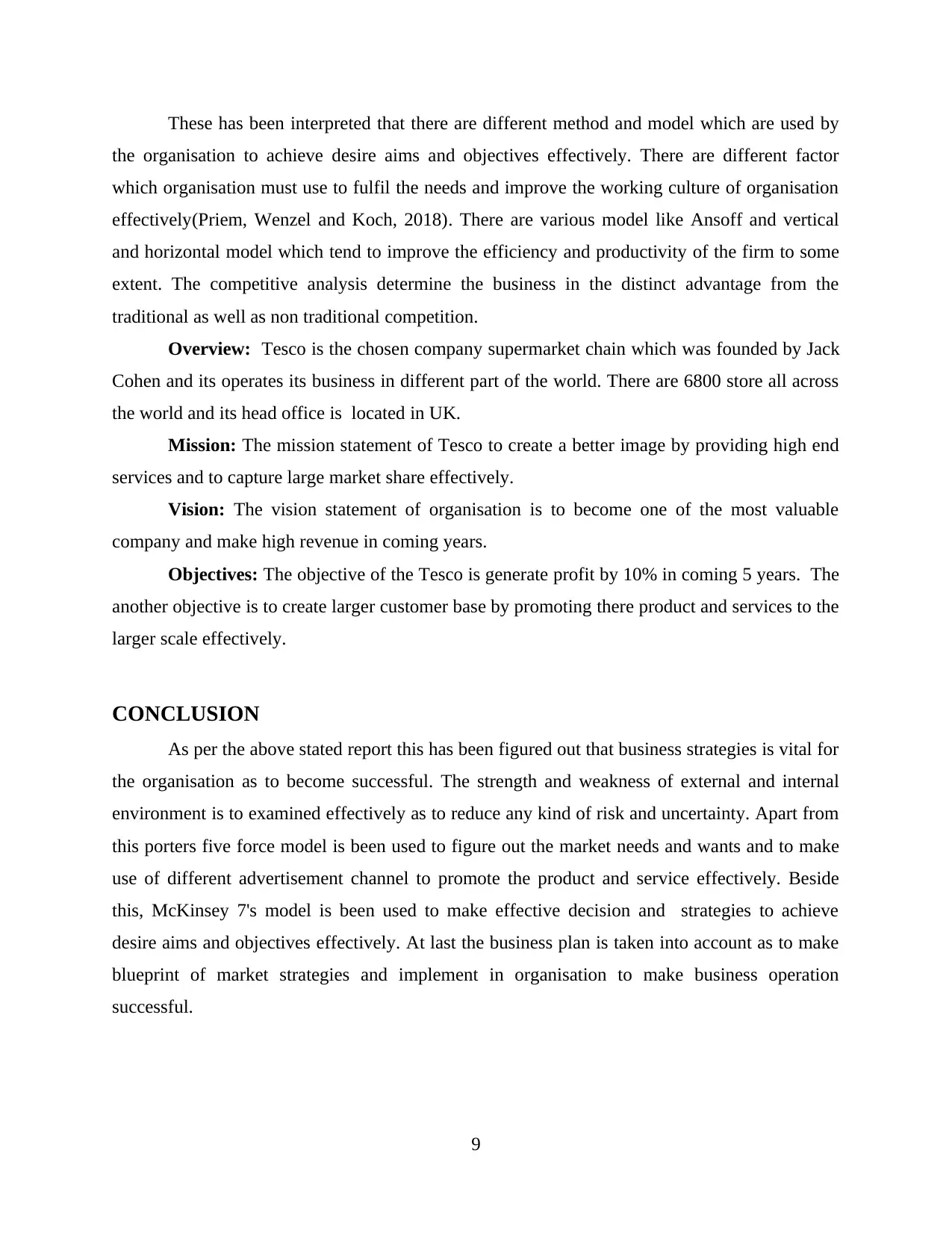
These has been interpreted that there are different method and model which are used by
the organisation to achieve desire aims and objectives effectively. There are different factor
which organisation must use to fulfil the needs and improve the working culture of organisation
effectively(Priem, Wenzel and Koch, 2018). There are various model like Ansoff and vertical
and horizontal model which tend to improve the efficiency and productivity of the firm to some
extent. The competitive analysis determine the business in the distinct advantage from the
traditional as well as non traditional competition.
Overview: Tesco is the chosen company supermarket chain which was founded by Jack
Cohen and its operates its business in different part of the world. There are 6800 store all across
the world and its head office is located in UK.
Mission: The mission statement of Tesco to create a better image by providing high end
services and to capture large market share effectively.
Vision: The vision statement of organisation is to become one of the most valuable
company and make high revenue in coming years.
Objectives: The objective of the Tesco is generate profit by 10% in coming 5 years. The
another objective is to create larger customer base by promoting there product and services to the
larger scale effectively.
CONCLUSION
As per the above stated report this has been figured out that business strategies is vital for
the organisation as to become successful. The strength and weakness of external and internal
environment is to examined effectively as to reduce any kind of risk and uncertainty. Apart from
this porters five force model is been used to figure out the market needs and wants and to make
use of different advertisement channel to promote the product and service effectively. Beside
this, McKinsey 7's model is been used to make effective decision and strategies to achieve
desire aims and objectives effectively. At last the business plan is taken into account as to make
blueprint of market strategies and implement in organisation to make business operation
successful.
9
the organisation to achieve desire aims and objectives effectively. There are different factor
which organisation must use to fulfil the needs and improve the working culture of organisation
effectively(Priem, Wenzel and Koch, 2018). There are various model like Ansoff and vertical
and horizontal model which tend to improve the efficiency and productivity of the firm to some
extent. The competitive analysis determine the business in the distinct advantage from the
traditional as well as non traditional competition.
Overview: Tesco is the chosen company supermarket chain which was founded by Jack
Cohen and its operates its business in different part of the world. There are 6800 store all across
the world and its head office is located in UK.
Mission: The mission statement of Tesco to create a better image by providing high end
services and to capture large market share effectively.
Vision: The vision statement of organisation is to become one of the most valuable
company and make high revenue in coming years.
Objectives: The objective of the Tesco is generate profit by 10% in coming 5 years. The
another objective is to create larger customer base by promoting there product and services to the
larger scale effectively.
CONCLUSION
As per the above stated report this has been figured out that business strategies is vital for
the organisation as to become successful. The strength and weakness of external and internal
environment is to examined effectively as to reduce any kind of risk and uncertainty. Apart from
this porters five force model is been used to figure out the market needs and wants and to make
use of different advertisement channel to promote the product and service effectively. Beside
this, McKinsey 7's model is been used to make effective decision and strategies to achieve
desire aims and objectives effectively. At last the business plan is taken into account as to make
blueprint of market strategies and implement in organisation to make business operation
successful.
9
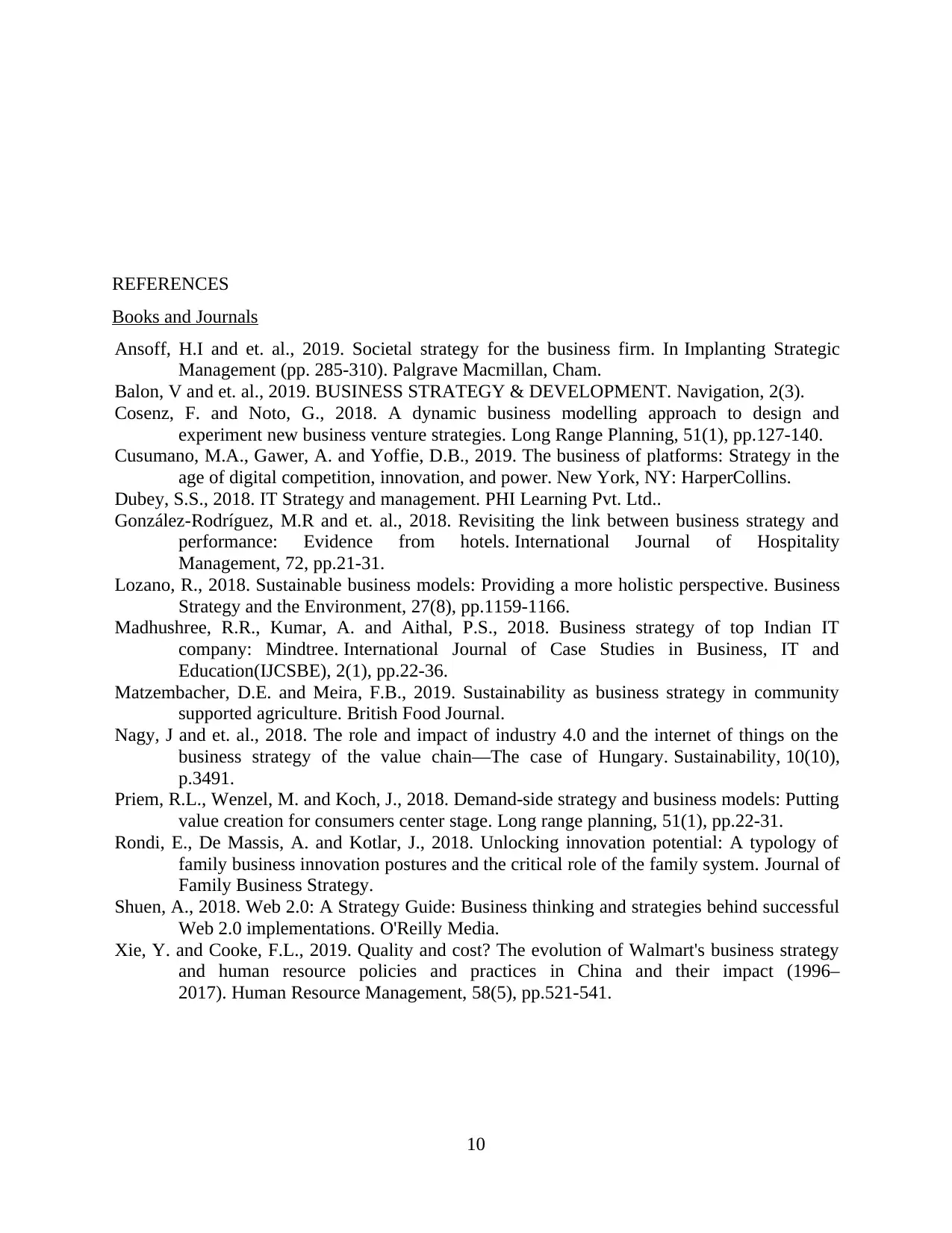
REFERENCES
Books and Journals
Ansoff, H.I and et. al., 2019. Societal strategy for the business firm. In Implanting Strategic
Management (pp. 285-310). Palgrave Macmillan, Cham.
Balon, V and et. al., 2019. BUSINESS STRATEGY & DEVELOPMENT. Navigation, 2(3).
Cosenz, F. and Noto, G., 2018. A dynamic business modelling approach to design and
experiment new business venture strategies. Long Range Planning, 51(1), pp.127-140.
Cusumano, M.A., Gawer, A. and Yoffie, D.B., 2019. The business of platforms: Strategy in the
age of digital competition, innovation, and power. New York, NY: HarperCollins.
Dubey, S.S., 2018. IT Strategy and management. PHI Learning Pvt. Ltd..
González-Rodríguez, M.R and et. al., 2018. Revisiting the link between business strategy and
performance: Evidence from hotels. International Journal of Hospitality
Management, 72, pp.21-31.
Lozano, R., 2018. Sustainable business models: Providing a more holistic perspective. Business
Strategy and the Environment, 27(8), pp.1159-1166.
Madhushree, R.R., Kumar, A. and Aithal, P.S., 2018. Business strategy of top Indian IT
company: Mindtree. International Journal of Case Studies in Business, IT and
Education(IJCSBE), 2(1), pp.22-36.
Matzembacher, D.E. and Meira, F.B., 2019. Sustainability as business strategy in community
supported agriculture. British Food Journal.
Nagy, J and et. al., 2018. The role and impact of industry 4.0 and the internet of things on the
business strategy of the value chain—The case of Hungary. Sustainability, 10(10),
p.3491.
Priem, R.L., Wenzel, M. and Koch, J., 2018. Demand-side strategy and business models: Putting
value creation for consumers center stage. Long range planning, 51(1), pp.22-31.
Rondi, E., De Massis, A. and Kotlar, J., 2018. Unlocking innovation potential: A typology of
family business innovation postures and the critical role of the family system. Journal of
Family Business Strategy.
Shuen, A., 2018. Web 2.0: A Strategy Guide: Business thinking and strategies behind successful
Web 2.0 implementations. O'Reilly Media.
Xie, Y. and Cooke, F.L., 2019. Quality and cost? The evolution of Walmart's business strategy
and human resource policies and practices in China and their impact (1996–
2017). Human Resource Management, 58(5), pp.521-541.
10
Books and Journals
Ansoff, H.I and et. al., 2019. Societal strategy for the business firm. In Implanting Strategic
Management (pp. 285-310). Palgrave Macmillan, Cham.
Balon, V and et. al., 2019. BUSINESS STRATEGY & DEVELOPMENT. Navigation, 2(3).
Cosenz, F. and Noto, G., 2018. A dynamic business modelling approach to design and
experiment new business venture strategies. Long Range Planning, 51(1), pp.127-140.
Cusumano, M.A., Gawer, A. and Yoffie, D.B., 2019. The business of platforms: Strategy in the
age of digital competition, innovation, and power. New York, NY: HarperCollins.
Dubey, S.S., 2018. IT Strategy and management. PHI Learning Pvt. Ltd..
González-Rodríguez, M.R and et. al., 2018. Revisiting the link between business strategy and
performance: Evidence from hotels. International Journal of Hospitality
Management, 72, pp.21-31.
Lozano, R., 2018. Sustainable business models: Providing a more holistic perspective. Business
Strategy and the Environment, 27(8), pp.1159-1166.
Madhushree, R.R., Kumar, A. and Aithal, P.S., 2018. Business strategy of top Indian IT
company: Mindtree. International Journal of Case Studies in Business, IT and
Education(IJCSBE), 2(1), pp.22-36.
Matzembacher, D.E. and Meira, F.B., 2019. Sustainability as business strategy in community
supported agriculture. British Food Journal.
Nagy, J and et. al., 2018. The role and impact of industry 4.0 and the internet of things on the
business strategy of the value chain—The case of Hungary. Sustainability, 10(10),
p.3491.
Priem, R.L., Wenzel, M. and Koch, J., 2018. Demand-side strategy and business models: Putting
value creation for consumers center stage. Long range planning, 51(1), pp.22-31.
Rondi, E., De Massis, A. and Kotlar, J., 2018. Unlocking innovation potential: A typology of
family business innovation postures and the critical role of the family system. Journal of
Family Business Strategy.
Shuen, A., 2018. Web 2.0: A Strategy Guide: Business thinking and strategies behind successful
Web 2.0 implementations. O'Reilly Media.
Xie, Y. and Cooke, F.L., 2019. Quality and cost? The evolution of Walmart's business strategy
and human resource policies and practices in China and their impact (1996–
2017). Human Resource Management, 58(5), pp.521-541.
10
⊘ This is a preview!⊘
Do you want full access?
Subscribe today to unlock all pages.

Trusted by 1+ million students worldwide
1 out of 12
Related Documents
Your All-in-One AI-Powered Toolkit for Academic Success.
+13062052269
info@desklib.com
Available 24*7 on WhatsApp / Email
![[object Object]](/_next/static/media/star-bottom.7253800d.svg)
Unlock your academic potential
Copyright © 2020–2025 A2Z Services. All Rights Reserved. Developed and managed by ZUCOL.





